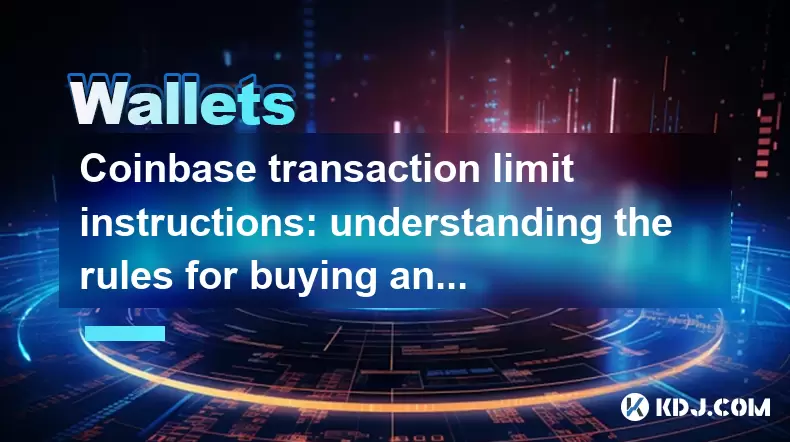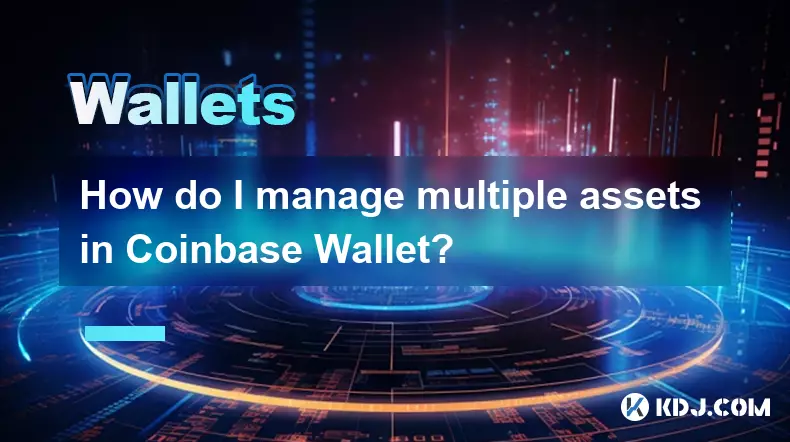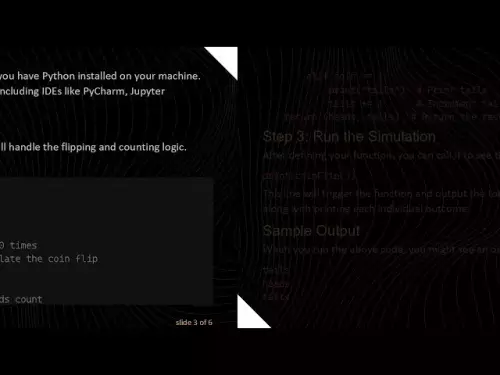-
 bitcoin
bitcoin $109490.807904 USD
-0.21% -
 ethereum
ethereum $4022.117216 USD
1.85% -
 tether
tether $1.000628 USD
0.01% -
 xrp
xrp $2.774535 USD
0.39% -
 bnb
bnb $960.032334 USD
0.86% -
 solana
solana $204.633655 USD
4.30% -
 usd-coin
usd-coin $0.999730 USD
-0.03% -
 dogecoin
dogecoin $0.232240 USD
2.70% -
 tron
tron $0.338268 USD
1.07% -
 cardano
cardano $0.790592 USD
1.76% -
 hyperliquid
hyperliquid $44.498874 USD
4.83% -
 ethena-usde
ethena-usde $1.000456 USD
0.08% -
 chainlink
chainlink $21.067044 USD
2.89% -
 avalanche
avalanche $28.920814 USD
0.87% -
 stellar
stellar $0.359386 USD
1.41%
Anweisungen zur COinbase -Transaktionsgrenze: Verständnis der Regeln für den Kauf und Verkauf von Grenzen
Coinbase sets transaction limits based on verification level, account history, and location to comply with regulations and prevent fraud.
Jul 08, 2025 at 09:50 am

Was ist die Münztransaktionsgrenze?
Das Coinbase -Transaktionsgrenze bezieht sich auf die maximale Menge an Kryptowährung oder Fiat -Währung, die ein Benutzer innerhalb eines bestimmten Zeitrahmens auf der Coinbase -Plattform kaufen, verkaufen, senden oder empfangen kann. Diese Grenzen sind vorhanden, um die Einhaltung der behördlichen Anforderungen zu gewährleisten und betrügerische Aktivitäten zu verhindern. Die genauen Grenzwerte variieren je nach Faktoren wie Benutzerüberprüfungsstufe , Kontoverlauf und geografischer Lage .
Benutzer, die eine grundlegende Identitätsüberprüfung abgeschlossen haben, sind in der Regel unter niedrigeren Grenzen im Vergleich zu denjenigen, die fortschrittliche Überprüfungsprozesse durchlaufen haben, wie die Bereitstellung von ID und den Adressnachweis der von der Regierung ausgestellten ID und Adressnachweise.
Wie werden Coinbase -Transaktionsgrenzen bestimmt?
Coinbase bestimmt Transaktionsgrenzen basierend auf mehreren Schlüsselkriterien:
- Überprüfungsstufe : Benutzern auf Coinbase werden verschiedene Bestätigungsebenen zugewiesen (Tier 0, Tier 1, Stufe 2 usw.). Höhere Ebenen haben normalerweise mit erhöhten täglichen und wöchentlichen Transaktionsgrenzen .
- Konto und Aktivität und Aktivität : Neue Konten beginnen häufig mit niedrigen Grenzen, die sich im Laufe der Zeit erhöhen, da das Konto vom System aktiver wird und vertrauen wird.
- Zahlungsmethode : Die Art der verwendeten Zahlungsmethode (z. B. Bankübertragung, Kreditkarte, PayPal) wirkt sich auf die Grenzen aus. Beispielsweise haben Kreditkartenkäufe häufig niedrigere Grenzen als ACH -Bankübertragungen.
- Standort : Regulatorische Umgebungen unterscheiden sich nach Land. Benutzer aus Regionen mit strengeren finanziellen Vorschriften können geringere Ausfallgrenzen haben.
Diese Regeln sind so konzipiert, dass sie sich an die Gesetze Ihres Kunden (KYC) und Anti-Geldwäsche (AML) anpassen sollen.
Tägliche gegen wöchentliche Transaktionsgrenzen
Bei Coinbase werden die Grenzen in der Regel in täglichen und wöchentlichen Mengen ausgedrückt. Diese Zurücksetzen in regelmäßigen Abständen:
- Tägliche Grenzen : Alle 24 Stunden zurücksetzen. Wenn Sie beispielsweise ein tägliches Limit von 5.000 US -Dollar für den Kauf von Krypto haben, können Sie jeden Tag bis zu diesem Betrag abwickeln.
- Wöchentliche Grenzen : Setzen Sie alle sieben Tage einmal zurück. Wenn Ihr wöchentliches Verkaufslimit 20.000 US-Dollar beträgt, können Sie diese Summe während des Sieben-Tage-Fensters nicht überschreiten.
Es ist wichtig zu beachten, dass diese Grenzen für alle Kryptowährungen gelten, sofern nicht anders angegeben. Wenn Sie beispielsweise im Kryptohandel auf 10.000 USD pro Woche begrenzt sind, umfasst dies Bitcoin, Ethereum und alle anderen unterstützten Münzen.
So überprüfen Sie Ihre aktuellen Transaktionsgrenzen auf Coinbase
Befolgen Sie die folgenden Schritte, um Ihre aktuellen Grenzen anzuzeigen:
- Melden Sie sich in Ihr Coinbase -Konto an .
- Klicken Sie in der oberen rechten Ecke auf das Profilsymbol .
- Navigieren Sie zum Abschnitt Limits unter der Registerkarte Konto.
- Hier sehen Sie detaillierte Informationen zu Ihrem Kauf, Verkauf, Senden und erhalten Grenzen .
Wenn eines der angezeigten Grenzen falsch oder veraltet erscheint, kann dies auf die jüngsten Änderungen Ihres Überprüfungsstatus oder auf temporäre Beschränkungen zurückzuführen sein, die durch verdächtige Aktivitätsflags verursacht werden.
So erhöhen Sie Ihre Coinbase -Transaktionsgrenzen
Die Erhöhung Ihrer Transaktionsgrenzen beinhaltet die Verbesserung der Vertrauenswürdigkeit und Überprüfung Ihres Kontos. Um dies zu tun:
- Vollständige Identitätsprüfung : Laden Sie eine gültige von der Regierung ausgestellte ID hoch und bestätigen Sie Ihre Wohnadresse.
- LINK Ein verifiziertes Bankkonto : Dies hilft, finanzielle Legitimität festzulegen und kann zu höheren Grenzen führen.
- Aspekte der Kontostabilität beibehalten : Vermeiden Sie häufige Anmeldungen von neuen Geräten oder Standorten, die Sicherheitsmaßnahmen auslösen und die Grenzwerte vorübergehend verringern können.
- Kontaktunterstützung : In einigen Fällen kann das Erreichen der Coinbase-Kundenbetreuung und das Anfordern einer manuellen Überprüfung zu einer Erhöhung der Grenzen führen, insbesondere für Händler mit hohem Volumen oder institutionelle Nutzer.
Denken Sie daran, dass auch nach Abschluss aller Überprüfungsschritte die Grenzen möglicherweise immer noch nicht sofort die höchstmöglichen Schwellenwerte erreichen. Coinbase bewertet das Kontoverhalten dynamisch und kann die Grenzwerte entsprechend anpassen.
Häufige Probleme im Zusammenhang mit Transaktionsgrenzen
Einige Benutzer stoßen auf Probleme, wenn Sie versuchen, große Transaktionen auszuführen:
- Plötzliche Grenzwerte : Dies kann nach einer ungewöhnlichen Anmeldetätigkeit oder wenn anhängige Überprüfungen vorliegen.
- Grenzwerte, die nach Überprüfung nicht aktualisiert werden : Manchmal kann das System bis zu 24 bis 48 Stunden dauern, um aktualisierte Grenzen nach der Einreichung der Überprüfungsdokumente widerzuspiegeln.
- Unstimmigkeiten zwischen Kauf- und Verkaufsgrenzen : Es ist normal, dass die Verkaufsgrenzen je nach Quelle und regionalen Richtlinien für die Finanzierung höher sind als Kaufgrenzen .
Wenn Sie anhaltende Probleme haben, empfiehlt Coinbase die Überprüfung Ihrer Sicherheitseinstellungen , die Bestätigung Ihrer Identitätsdokumentation und die Kontaktaufnahme mit ihrem Support -Team, um Unterstützung zu erhalten.
Häufig gestellte Fragen
F: Kann ich mit mehreren Konten die Transaktionsgrenzwerte der Coinbase -Transaktion umgehen? A: Nein, der Versuch, die Grenzwerte durch Erstellen zusätzlicher Konten zu umgehen, verstößt gegen die Nutzungsbedingungen von Coinbase und kann zu Einfrierungen für Kontoeinspannungen oder Fonds führen.
F: Gilten Transaktionsgrenzen für Krypto-zu-Krypto-Trades? A: Im Allgemeinen unterliegen Krypto-zu-Krypto-Geschäfte nicht den gleichen Fiat-basierten Grenzen , können jedoch dennoch auf ungewöhnliche Aktivitäten überwacht oder zur Überprüfung gekennzeichnet.
F: Warum nahm meine Münzverbindungstransaktionsgrenze ohne Vorankündigung ab? A: Die Grenzwerte können aufgrund von Sicherheitsauslöschern abnehmen, z. B. die Anmeldung von einem neuen Gerät, das Einleiten mehrerer Abhebungen oder den Nichtunterhaltungsstatus.
F: Sind Coinbase -Transaktionsgrenzen weltweit gleich? A: Nein, die Grenzwerte variieren je nach Wohnsitzland und lokalen regulatorischen Rahmenbedingungen erheblich. Einige Länder haben möglicherweise auch spezifische Einschränkungen für bestimmte Arten von Transaktionen oder Kryptowährungen.
Haftungsausschluss:info@kdj.com
Die bereitgestellten Informationen stellen keine Handelsberatung dar. kdj.com übernimmt keine Verantwortung für Investitionen, die auf der Grundlage der in diesem Artikel bereitgestellten Informationen getätigt werden. Kryptowährungen sind sehr volatil und es wird dringend empfohlen, nach gründlicher Recherche mit Vorsicht zu investieren!
Wenn Sie glauben, dass der auf dieser Website verwendete Inhalt Ihr Urheberrecht verletzt, kontaktieren Sie uns bitte umgehend (info@kdj.com) und wir werden ihn umgehend löschen.
-
 LIGHT Jetzt handeln
LIGHT Jetzt handeln$0.4179
2776.85%
-
 APEX Jetzt handeln
APEX Jetzt handeln$2.48
185.44%
-
 ALPINE Jetzt handeln
ALPINE Jetzt handeln$5.11
138.25%
-
 OVPP Jetzt handeln
OVPP Jetzt handeln$0.1044
89.27%
-
 UXLINK Jetzt handeln
UXLINK Jetzt handeln$0.1645
76.33%
-
 MYX Jetzt handeln
MYX Jetzt handeln$14.56
58.57%
- BTC, Hardgabel und umstrittene Futures: Eine Bitcoin -Knoten -Kontroverse
- 2025-09-28 01:05:16
- Litecoin, Remittix und Kryptozahlungen: Eine neue Ära?
- 2025-09-28 01:05:16
- Crypto Presales: Ist $ BFX das nächste große Ding?
- 2025-09-28 00:25:12
- Krakens IPO -Ambitionen: Navigation der Bewertung in einem erholenden Kryptomarkt
- 2025-09-28 00:25:12
- World Liberty Financial (WLFI): Rückkauf & Brennen Bonanza - Wird sich der Preis entzünden?
- 2025-09-28 00:45:12
- Bitcoins holprige Fahrt: Navigieren Sie Risiken und potenzielle Abschwung
- 2025-09-28 00:30:01
Verwandtes Wissen

Wie sehe ich die Smart Contract -Interaktionsgeschichte in Coinbase Wallet?
Sep 24,2025 at 01:36am
Zugriff auf Smart Contract Interaction History in Coinbase Wallet 1. Öffnen Sie die Coinbase -Wallet -Anwendung auf Ihrem mobilen Gerät und melden Sie...

Wie benutze ich die Token -Swap -Funktion in Coinbase Wallet?
Sep 24,2025 at 05:00pm
Token -Swaps in Coinbase -Brieftasche verstehen 1. Mit der Token -Swap -Funktion in Coinbase Wallet können Benutzer eine Kryptowährung für einen ander...

Wie nehme ich an der Voting von Governance in Coinbase Wallet teil?
Sep 25,2025 at 01:55pm
Verständnis der Marktvolatilität im Krypto -Raum 1. Kryptowährungsmärkte sind für ihre extremen Preisschwankungen bekannt, die häufig von Stimmung, ma...

Wie richte ich einen benutzerdefinierten RPC -Knoten in Coinbase Wallet ein?
Sep 24,2025 at 12:00pm
Verständnis für benutzerdefinierte RPC -Knoten in Coinbase Wallet 1. Ein benutzerdefinierter RPC -Knoten (Remote Procedure Call) ermöglicht es Benutze...

Wie verwalte ich mehrere Vermögenswerte in Coinbase Wallet?
Sep 23,2025 at 10:00am
Verständnis der Unterstützung von Multi-Asset-Unterstützung in Coinbase Wallet Mit 1. Coinbase Wallet können Benutzer eine Vielzahl von digitalen Asse...

Wie verbinde ich Coinbase -Brieftasche mit einer Hardware -Brieftasche?
Sep 26,2025 at 02:54am
Anschließen von Coinbase -Brieftaschen mit einem Hardware -Gerät 1. Öffnen Sie die Coinbase Wallet -App auf Ihrem Mobilgerät und stellen Sie sicher, d...

Wie sehe ich die Smart Contract -Interaktionsgeschichte in Coinbase Wallet?
Sep 24,2025 at 01:36am
Zugriff auf Smart Contract Interaction History in Coinbase Wallet 1. Öffnen Sie die Coinbase -Wallet -Anwendung auf Ihrem mobilen Gerät und melden Sie...

Wie benutze ich die Token -Swap -Funktion in Coinbase Wallet?
Sep 24,2025 at 05:00pm
Token -Swaps in Coinbase -Brieftasche verstehen 1. Mit der Token -Swap -Funktion in Coinbase Wallet können Benutzer eine Kryptowährung für einen ander...

Wie nehme ich an der Voting von Governance in Coinbase Wallet teil?
Sep 25,2025 at 01:55pm
Verständnis der Marktvolatilität im Krypto -Raum 1. Kryptowährungsmärkte sind für ihre extremen Preisschwankungen bekannt, die häufig von Stimmung, ma...

Wie richte ich einen benutzerdefinierten RPC -Knoten in Coinbase Wallet ein?
Sep 24,2025 at 12:00pm
Verständnis für benutzerdefinierte RPC -Knoten in Coinbase Wallet 1. Ein benutzerdefinierter RPC -Knoten (Remote Procedure Call) ermöglicht es Benutze...

Wie verwalte ich mehrere Vermögenswerte in Coinbase Wallet?
Sep 23,2025 at 10:00am
Verständnis der Unterstützung von Multi-Asset-Unterstützung in Coinbase Wallet Mit 1. Coinbase Wallet können Benutzer eine Vielzahl von digitalen Asse...

Wie verbinde ich Coinbase -Brieftasche mit einer Hardware -Brieftasche?
Sep 26,2025 at 02:54am
Anschließen von Coinbase -Brieftaschen mit einem Hardware -Gerät 1. Öffnen Sie die Coinbase Wallet -App auf Ihrem Mobilgerät und stellen Sie sicher, d...
Alle Artikel ansehen









































































